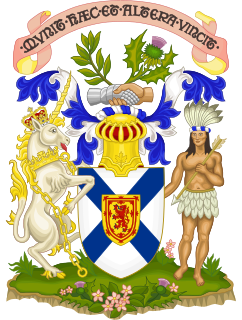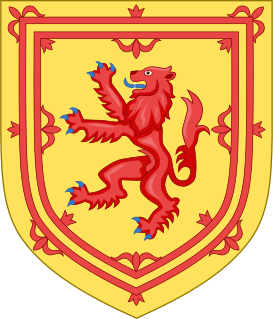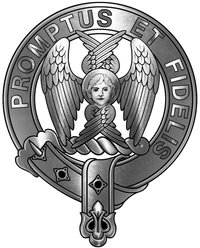
Heraldry is a discipline relating to the design, display and study of armorial bearings, as well as related disciplines, such as vexillology, together with the study of ceremony, rank and pedigree. Armory, the best-known branch of heraldry, concerns the design and transmission of the heraldic achievement. The achievement, or armorial bearings usually includes a coat of arms on a shield, helmet and crest, together with any accompanying devices, such as supporters, badges, heraldic banners and mottoes.

The coat of arms of Nova Scotia is the heraldic symbol representing the Canadian province of Nova Scotia. It is the oldest provincial achievement of arms in Canada, and the oldest British coat of arms in use outside Great Britain. It is blazoned as follows: Argent, a saltire azure charged with an escutcheon of the Royal Arms of Scotland.

Tincture is the limited palette of colours and patterns used in heraldry. The need to define, depict, and correctly blazon the various tinctures is one of the most important aspects of heraldic art and design.

In heraldry, variations of the field are any of a number of ways that a field may be covered with a pattern, rather than a flat tincture or a simple division of the field.

The coat of arms of Birmingham – the heraldic emblem of the English city of Birmingham – was first used in 1838 and has changed several times since, as the former town grew and developed into a city.

In heraldry, an ordinary is a simple geometrical figure, bounded by straight lines and running from side to side or top to bottom of the shield. There are also some geometric charges known as subordinaries, which have been given lesser status by some heraldic writers, though most have been in use as long as the traditional ordinaries. Diminutives of ordinaries and some subordinaries are charges of the same shape, though thinner. Most of the ordinaries are theoretically said to occupy one-third of the shield; but this is rarely observed in practice, except when the ordinary is the only charge.

The coat of arms of Toronto, Ontario, Canada, was designed by Robert Watt, the Chief Herald of Canada at the time, for the City of Toronto after its amalgamation in 1998. The arms were granted by the Canadian Heraldic Authority on 11 January 1999.

The coat of arms of Luxembourg has its origins in the Middle Ages and was derived from the arms of the Duchy of Limburg, in modern-day Belgium and the Netherlands. In heraldic language, the arms are described as: Barry of ten Argent and Azure, a Lion rampant queue forchée Gules crowned, armed and langued Or.

The first coat of arms of Montreal was designed by Jacques Viger, the first mayor of Montreal, and adopted in 1833 by the city councillors. Modifications were made some one hundred five years later and adopted on 21 March 1938, and again on 13 September 2017, resulting in the version currently in use. The coat of arms was the only city emblem representing Montreal until 1981, when a stylized logo was developed for common daily use, reserving the coat of arms for ceremonial occasions.

The royal arms of Scotland is the official coat of arms of the King of Scots first adopted in the 12th century. With the Union of the Crowns in 1603, James VI inherited the thrones of England and Ireland and thus his arms in Scotland were now quartered with the arms of England with an additional quarter for Ireland also added. Though the kingdoms of England and Scotland would share the same monarch, the distinction in heraldry used in both kingdoms was maintained. When the kingdoms of Scotland and England were united under the Acts of Union 1707 to form the Kingdom of Great Britain, no single arms were created, thereby maintaining the convention that the royal arms used in Scotland would continue to differ from those used elsewhere.

The coat of arms of Gabon was designed by the Swiss heraldist and vexillologist Louis Mühlemann, one of the founding members of the FIAV and the designer of the coat of arms of the Republic of Congo. It has been in use since 15 July 1963.

The most basic rule of heraldic design is the rule of tincture: metal should not be put on metal, nor colour on colour. This means that the heraldic metals or and argent should not be placed on each other, nor may any of the colours be placed on another colour. Heraldic furs as well as "proper" are exempt from the rule of tincture.

In heraldry, a bordure is a band of contrasting tincture forming a border around the edge of a shield, traditionally one-sixth as wide as the shield itself. It is sometimes reckoned as an ordinary and sometimes as a subordinary.

The coat of arms of Kirklees Metropolitan Borough Council was granted on 24 June 1974. This was just a few months after the district of Kirklees was created as part of the new metropolitan county of West Yorkshire. It is rarely used by the Council who, until 2007, preferred to use a logo that is based upon the arms.

The Coat of arms of West Yorkshire Metropolitan County Council was granted in 1975 to the new Metropolitan county council created in the previous year. The County Council was abolished in 1986 under the provisions of the Local Government Act 1985 and consequently the arms are no longer used. The current West Yorkshire Combined Authority uses a wordmark consisting of the authorities name.

The Coat of arms of Bradford City Council was granted in 1976. The present City of Bradford was created in 1974 by the Local Government Act 1972 and is one of five metropolitan boroughs of West Yorkshire. The 1976 arms are based on those of its predecessor, the county borough of Bradford.

The coat of arms of Wigan Metropolitan Borough Council was granted by the College of Arms in 1974.

In heraldry and heraldic vexillology, a blazon is a formal description of a coat of arms, flag or similar emblem, from which the reader can reconstruct the appropriate image. The verb to blazon means to create such a description. The visual depiction of a coat of arms or flag has traditionally had considerable latitude in design, but a verbal blazon specifies the essentially distinctive elements. A coat of arms or flag is therefore primarily defined not by a picture but rather by the wording of its blazon. Blazon is also the specialized language in which a blazon is written, and, as a verb, the act of writing such a description. Blazonry is the art, craft or practice of creating a blazon. The language employed in blazonry has its own vocabulary, grammar and syntax, which becomes essential for comprehension when blazoning a complex coat of arms.

The Coat of arms of Penang is largely based on the coat of arms of Penang first granted to the Settlement of Penang, then in the Federation of Malaya, by a Royal Warrant of King George VI dated 11 September 1949.

Clan Carruthers is a Lowland Scottish clan of the Scottish Borders headed by their Chief, Simon Peter Carruthers of Holmains and is recognised as such by the Lord Lyon King of Arms.


















